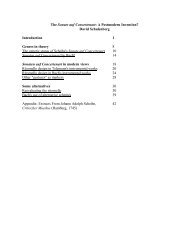SEVEN PAPERS ON EXISTENTIAL ANALYSIS ... - Wagner College
SEVEN PAPERS ON EXISTENTIAL ANALYSIS ... - Wagner College
SEVEN PAPERS ON EXISTENTIAL ANALYSIS ... - Wagner College
You also want an ePaper? Increase the reach of your titles
YUMPU automatically turns print PDFs into web optimized ePapers that Google loves.
een working out. For scientific psychology (in all of its one hundred years), mental<br />
representations have been believed to be the objects of consciousness. It seems clear,<br />
however, that there is no assurance the things as they are represented by me match the things<br />
as they are for you, for example, unless we agree to base our explanation of "mental<br />
representation" on the structures of the brain as they might be observed side-by-side by means<br />
of simultaneous imaging processes. In that case, identically responding brains would presumably<br />
provide evidence of identical representations of the same external object (24). The current<br />
doctrine of physiological psychology, which is currently the most sophisticated kind of empirical<br />
psychology, offer just such an explanation. But does this account reflect what we experience?<br />
Here is the point. Your experience of things is different from mine because the things that<br />
present themselves to you are different than the things that present themselves to me. The issue<br />
is not the (presumed) identity of brain states but of the presumed sameness of things perceived.<br />
Our representations are different because things are different for you and for me. How they<br />
appear (in an active sense) depends upon what my world is for me in which the things confront<br />
me. What this means is that I depends as much on things for who I am as things depends on me<br />
for their meaning. This "who I am" is my existence.<br />
Most would agree that our memories, dreams, hallucinations, and fantasies are unique to<br />
us, but that is true for our perceptions as well, which predate the other modes of beingconsciousness.<br />
You and I need not worry about finding an explanation of how to bring our<br />
representations in line with one another in order to have some assurance that we share the<br />
same real world, since, in any case, things are different for each of us. This does not challenge<br />
the reality measured by physicists, but merely says that we do not experience the world that<br />
electronic instruments record. If I am an architect, the World Trade Towers were something<br />
different than if was a tourist seeing them for the first time, or a potential suicide, or acrophobic,<br />
or . . .. Each of us perceived them differently because they are different places (topoi) for each<br />
of us (25). Similarly, a college classroom is different for a student, a state building inspector, a<br />
maintenance worker, a teacher, or the dean of the college, because it is a different place for<br />
each of them.<br />
The problem of the reality of the world has been taken up as a problem by<br />
phenomenologists, but as a result of its superfluousness in matters of the workings of beingconsciousness,<br />
the problem has disappeared. With it, need for an inner world has also<br />
disappeared. An inner world is needed to house mental representations, but if such<br />
representations are irrelevant to the discussion of being-consciousness, there is no need for such<br />
a "second world" that is supposed to mirror or replicate the real world (26).<br />
The so-called private world of perception and memory, imagination and motivation that<br />
has been explored extensively by psychoanalysts is nothing but my past and, above all, its<br />
future, which however are also there at the things of which I am consciousness when I recollect,<br />
will or imagine. And so it is for hallucinations, fantasies, and dreams, which are also there at the<br />
things that call for them.<br />
All of the evidence makes it seems likely that consciousness is never completely<br />
extinguished, even during deep sleep or while sedated by general anesthesia. The brightness of<br />
my being-consciousness corresponds to the degree of its openness – what Heidegger the<br />
clearing of existence – in relation to the things of which it is consciousness. This ranges from the<br />
minimal openness to sensory stimulation that prevails during deep sleep to the full shining of<br />
consciousness while validating an other's existence.<br />
I may now at long last return to the question raised earlier: What kind of object is my own<br />
being-consciousness for me? The answer is implicit in what we have just said. We have seen that<br />
its origin is with those who first validate my existence, and its site is the body I am. My beingconsciousness<br />
is a reply to the things that call out to me for meaning, but this relation that<br />
characterizes being-consciousness cannot become an object for my consciousness. I must<br />
conclude that it is as elusive as my existence. I know about it only through the fact of my















